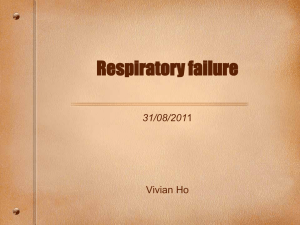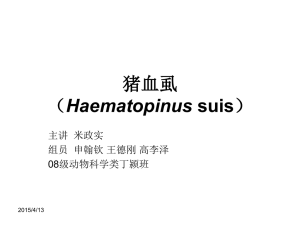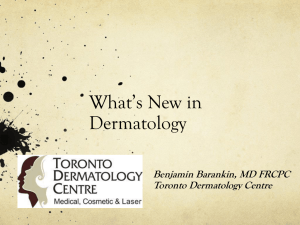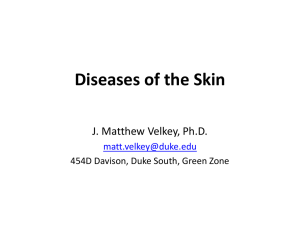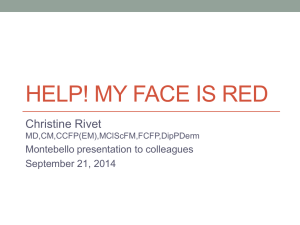Mark Jansen, M.D.
advertisement
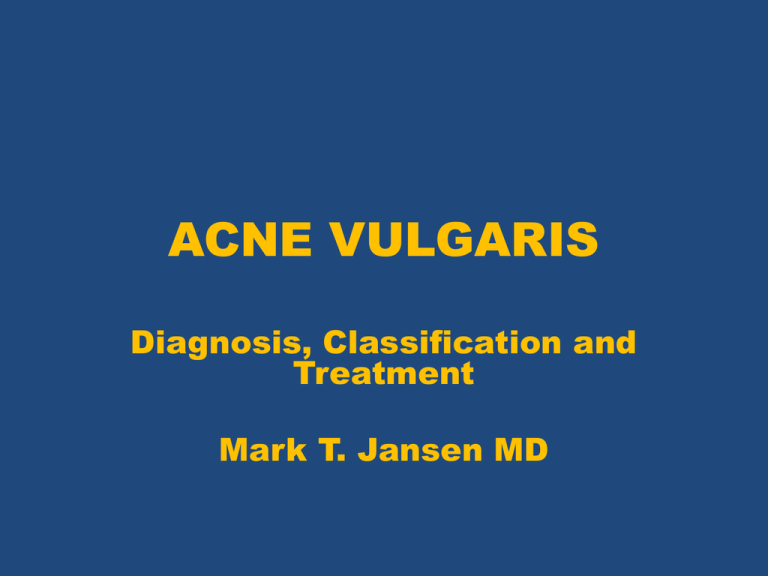
ACNE VULGARIS Diagnosis, Classification and Treatment Mark T. Jansen MD Disclosures “I have nothing to disclose” Mark T. Jansen MD Acne Incidence and Prevalence • Most common in 15 to 42 yo range • Affecting up to 100% age 12 to 17 • In US, 50 million experience acne each year • Approximately 7.7 million acnerelated visits in US each year Cost • Yearly, 2.2 billion spent on acne care in US • 1.7 billion on prescriptions • 320 million on OTC products • Other costs related to office visits Etiology • Increased sebum production • Increased proliferation and decreased desquamation of keratinocytes • Propionibacterium acnes in follicles (anaerobic diphtheroid, normal flora) • Comedone formation / inflammation Pathogenesis • Adrenarche (prepubertal rise in DHEA-S) • Sebaceous gland hypertrophy • Increased sebum production • Sebum-growth medium P. acnes • Proliferation of P. acnes surface proteins-inflammation by triggering humoral and cellmediated immune response Etiology Misconceptions • “Blackheads are caused by dirt and poor hygiene” • “If you wash harder, you wouldn’t have acne” • “You have acne because you eat too much chocolate” Etiology Misconceptions? • Milk – Nurses Health Study (47,000) women. • Insulin Growth Factor (IGF) - Acne • Milk high in IGF • > 3 portions of milk/week associated with ^ incidence Acne • High glycemic foods ^ IGF Etiology Misconceptions? • Family History - > 3 fold risk if 1st degree family member had acne • Stress – No affect on sebum production but severity worse with ^ stress, especially males • BMI – Positive association - ^ BMI with ^ risk of acne for females only Types of Lesions • Microcomedone – Precursor of the clinical lesions of acne (8 wks. to mature) • Closed comedone • Open comedone • Inflammatory papule • Inflammatory pustule • Inflammatory nodule Microcomedo Closed Comedone Open Comedone Inflammatory Papules Inflammatory Pustules Inflammatory Nodules and Nodulocystic Acne (cystic acne conglobata) Treatment • Who is the “patient”? • “Buy in” by patient • Simpler regimen better than complex • Cost of therapy considerations Treatment • Pustules can be converted to nodules and papules quickly • Inflammation and Post-inflammatory hyperpigmentation (PIH) slower to improve • Establish realistic timetable and treatment end-point • Consider long term consequences of the disease – trivial/short term vs. significant long term (scarring)? Psychosocial “Complications” of Acne Psychosocial “Complications” • Acne correlated with higher rates of: Depression Anxiety Social withdrawal Poor self esteem Suicide ideation Overall quality of life General Guidelines Negotiate patient “buy in” Establish realistic goals of treatment Simplify regimens Consider cost of therapy Inquire about OTC products that may ^ side effects or sabotage therapy • Encourage water-based lotions, cosmetics and hair products (less comedogenic) over oil-based products • • • • • Treatment • Most effective treatment addresses core factors promoting disease: Follicular hyperproliferation and abnormal desquamation Increased sebum production Propionibacterium acnes (P. acnes) proliferation Inflammation Pathogenesis Specific Agents Follicular hyperproliferation and abnormal desquamation Topical Retinoids (Tretinoin, Adapalene and Tazarotene) normalize follicular hyperkeratosis and normalize desquamation which prevents formation of micorcomedo Pathogenesis Specific Agents Topical Retinoids Vitamin A derivatives bind to receptors in keratinocytes Normalize follicular keratinization Decrease cohesiveness of keratinocytes reducing follicular occlusion and microcomedo formation Pathogenesis Specific Agents Topical Retinoids Anti-inflammatory effects Bind specifically to receptors that down regulate formation of proinflammatory protein AP-1 and expression of toll-like receptor (TLR)2 Pathogenesis Specific Agents Topical Retinoids Accelerate resolution of acneinduced post-inflammatory hyperpigmentation (PIH) PIH more common in patients with darker complexions Pathogenesis Specific Agents Topical Retinoids Tretinoin (Retin-A, Retin- Micro and generics) Adapalene (Differin and generics) Tazarotene (Tazorac – no generic psoriasis – pregnancy X) Pathogenesis Specific Agents Topical Retinoids Pearls of application Tretinoin (Retin-A) photo labile so night-time application preferred Only 19% stable 2 hours after UV sunlight exposure Pathogenesis Specific Agents Topical Retinoids Pearls of application Avoid tretinoin with benzoyl peroxide Oxidizes tretinoin especially with light exposure, inactivating drug Pathogenesis Specific Agents Topical Retinoids Pearls of Application Adapalene (Differin) and tretinoin gel microsphere (Retin-A Micro) more light stable Adapalene more stable in presence of benzoyl peroxide (combo Epiduo) Pathogenesis Specific Agent Agent Pro Con Tretinoin Generic available, multiple strengths 0.01% gel, 0.025% cream/gel, 0.05% cream, 0.1% cream Degraded by light and benzoyl peroxide. Avoid in pregnancy. gels more irritating than creams Adapalene Generic available in 0.1% cream/gel. Trade name only in 0.1% lotion, 0.3%gel. Light stable. Less irritating. Can be used with BP Some formulations trade name only. Avoid in pregnancy Tazarotene Psoriasis and acne. Best for PIH. Most effective. Available in 0.05% and 0.1% cream or gel No generic currently. Most irritating. Pregnancy category X Pathogenesis Specific Agents Retinoid Intolerance Irritation, dryness and flaking, worse in 1st month Avoid concomitant harsh soaps, toners, astringents, alpha hydroxy acids and salicylic acids Pathogenesis Specific Agents Retinoid Intolerance Consider application every 2nd or 3rd night Avoid “typical” soaps which have a pH of 9 to 10. Use synthetic detergent cleansers with a pH of 5.5 to 7 (Cetaphil, Dove Sensitive Skin Bar) Pathogenesis Specific Agents Retinoid Intolerance For true retinoid intolerance, consider alternatives: Azelaic acid – 15% gel (Finacea) and 20% cream (Azelex). Antimicrobial, comedolytic and anti-inflammatory comparable efficacy to tretinoin 0.05% cream Pathogenesis Specific Agents Retinoid Intolerance Alternatives continued: Salicylic acid. Induces keratolysis. Available in gel and pads with 0.5% and 2% as well as multiple products (cream, cloths, foam, cleansers, patches, pads, soaps, shower gels) of 2% concentration Pathogenesis Specific Agents Sebum production and the role of Androgens DHEA-S – Testosterone – DHT (all in the sebaceous gland) DHT attaches to receptors in the sebaceous gland that upregulate sebum production Pathogenesis Specific Agents Anti-androgenic agents OCAs – Low dose combination products estrogen dominant which makes them “anti-androgenic” Drospirenone containing pills (Yazmin and Yaz) may be superior in antiandrogenic effect (potassium sparing – monitor potassium during 1st cycle) Pathogenesis Specific Agents Third generation progestins Norgestimate Desogestrel (Less androgenic) Gestodene Second generation progestins Levonorgestrel Norethindrone (More androgenic) Pathogenesis Specific Agents Progestin-only Contraceptives Androgenic Low dose (mini-pill) Medroxyprogesterone injections Levonorgestrel IUD (Mirena) Etonogestrel implant (Implanon) Pathogenesis Specific Agents Androgen Receptor Blockers Spironolactone – Blocks androgen receptors and inhibits androgen biosynthesis (off-label use) 50 to 100mg/day in two divided doses Pathogenesis Specific Agents Spironolactone (continued) Monitor for hyperkalemia and hypotension at 4 and 6 wks. Black box warning (tumorigenic in chronic toxicity animal studies) Pregnancy category C – feminization of male fetus. Strongly consider OCAs Pathogenesis Specific Agents Antimicrobials Reduce Colonization of P. acnes Topical antimicrobials Oral antimicrobials (antibiotics) Pathogenesis Specific Agents Topical Antimicrobials Benzoyl peroxide (antimicrobial and comedolytic) Clindamycin Erythromycin Sulfacetamide Dapsone Pathogenesis Specific Agents Benzoyl peroxide Available in US in both Rx and OTC in 2.5% up to 10% gels, lotions, bars, pads, masks and liquid cleansers Applied BID Higher concentration not necessarily better. Higher concentrations more irritating and all may bleach hair/clothing Pathogenesis Specific Agents Clindamycin 1% concentrations in gel, solution, lotion, foam and pledgets Not effective as monotherapy. Use in combination with either retinoids or benzoyl peroxide to increase efficacy and reduce bacterial resistance. Pathogenesis Specific Agents Clindamycin Generic widely available in all forms Topical may be irritating. Prolonged use may predispose to fungal or bacterial superinfections including C. difficile. Warn to notify if patient develops diarrhea or bloody stool. Less likely than with oral form Pregnancy risk B Pathogenesis Specific Agents Erythromycin 2% concentrations in gel and solution formulations Avoid monotherapy. Consider combination with retinoid or benzoyl peroxide to increase efficacy and decrease bacterial resistance Pathogenesis Specific Agents Erythromycin Generic widely available in all forms May be irritating. Minimal systemic absorption. Potential for GI side effect minimal. Pregnancy risk B Pathogenesis Specific Agents Sulfacetamide Typically combined with 5% sulfur Not usually 1st line therapy Avoid in patients with allergy to sulfa or sulfonamide Pathogenesis Specific Agents Sulfacetamide Widely available as 10% gel, liquid, suspension, cream, lotion and pads Pregnancy risk C. Consider avoiding in potentially fertile females Pathogenesis Specific Agents Dapsone Topical 5% dapsone gel is newest topical antimicrobial that also has anti-inflammatory activity Unlike oral dapsone, no practical concern for use in individuals with G6PD deficiency. No associated hemolytic anemia or methemoglobinemia issues Pathogenesis Specific Agents Dapsone Not a sulfa. Not contraindicated in sulfa allergic patients Applied BID. No generic. May discolor skin/hair yellow-orange when used with benzoyl peroxide Pathogenesis Specific Agents Combination Topical Therapy Combination topical therapy shown to be more effective than monotherapy Evidence-based confirmation of superior efficacy of topical retinoids in combination with topical clindamycin, erythromycin or benzoyl peroxide Pathogenesis Specific Agents Combination Topical Therapy Two fixed antimicrobial / retinoid combinations available in US Clindamycin 1.2% / tretinoin 0.025% gel (Ziana, Veltin) Benzoyl peroxide 2.5% / adapalene 0.1% (Epiduo) Pathogenesis Specific Agents Combination Topical Therapy Resistance to topical antibiotics now widespread No resistance of P. acnes to benzoyl peroxide yet Combining topical antibiotics with benzoyl peroxide decreases development of resistance and improves treatment efficacy Pathogenesis Specific Agents Combination Topical Therapy Topical benzoyl peroxide / antibiotic combinations in US: BP 5% / clindamycin 1% gel (Benzaclin, Duac) BP 5% / erythromycin 3% gel (Benzamycin) BP 2.5% / clindamycin 1.2% gel (Acanya) Pathogenesis Specific Agents Topical Therapy Azelic acid – antimicrobial, comedolytic and anti-inflammatory properties 20% cream (Azelex), 15% gel (Finacea approved in US for rosacea only) applied BID Equally efficacious to tretinoin 0.05% cream, BP 5% gel or 2% erythromycin Pathogenesis Specific Agents Oral Antibiotics Indicated for moderate to severe inflammatory acne May be used for patients with milder acne of the trunk where application of topicals are more problematic Pathogenesis Specific Agents Oral Antibiotics Inhibit growth of P. acnes in pilosebaceous unit Tetracycline class have anti-inflammatory properties too Systemic antibiotics tend more rapid clinical improvement than topicals but carry risk of more side effects (candidiasis, GI distress, significant allergic or toxic reaction) Pathogenesis Specific Agents Oral Antibiotics Prescribe for a limited course of 3 to 6 months to reduce risk of antibiotic resistance Consider discontinuation as acne improves No consensus as stopping systemic drug abruptly or in tapering fashion Pathogenesis Specific Agents Oral Antibiotics Tetracyclines (doxycycline, minocycline) Macrolides (erythromycin, azithromycin) Trimethoprim-sulfamethoxazole Clindamycin Pathogenesis Specific Agents Oral Antibiotics Emerging resistance of P. acnes 20% in 1978. 62% in 1996 Most common with erythromycin Least common with minocycline Pathogenesis Specific Agents Oral Antibiotics Reducing emergence of resistance: Use only when necessary. Limit treatment to < 6 mos. Stop if no additional improvement noted Give choice a minimum of 6 to 8 weeks (length of time-microcomedone to mature clinical lesion) Pathogenesis Specific Agents Oral antibiotics Reducing resistance continued: Change after 6 to 8 weeks if no response Partial response – continue 1st choice and reassess in 6 to 8 more weeks Pathogenesis Specific Agents Oral Antibiotics Reducing resistance continued: If stopped antibiotic needs to be restarted and was effective, resume same drug as long as works Avoid combination therapy with oral and topical antibiotics that have different mechanism of action Prescribe topical BP at start of oral antibiotic therapy Pathogenesis Specific Agents Oral Antibiotics Reducing resistance continued: Consider topical retinoid at initiation of oral antibiotic. Decreases resistance and more efficacious Consider topical retinoids for long term maintenance to decrease oral antibiotic use and sustain improvement Pathogenesis Specific Agents Oral Antibiotics Macrolides – Erythromycin, azithromycin Resistance now common GI side effects Consider only in patients where tetracyclines are contraindicated Pathogenesis Specific Agents Oral Antibiotics Tetracyclines – Hard to get tetracycline. Inactivated by food Doxycycline / minocycline not affected by food. Have anti-inflammatory effects. Minocycline has less resistance than doxycycline but generally higher cost Pathogenesis Specific Agents Oral Antibiotics Tetracyclines continued: Avoid < 9 yo and women who are or may become pregnant – teeth GI distress Esophagitis Pseudotumor cerebri, vertigo (minocycline) Photosensitivity, skin or liver discoloration Pathogenesis Specific Agents Oral Antibiotics Subantimicrobial doxycycline Maintains anti-inflammatory activity without antibacterial effect Maintains improvement in inflammatory acne without inducing resistance. 20mg BID Pathogenesis Specific Agents Oral Antibiotics Alternative oral antibiotics Trimethoprim – sulfamethoxazole Effective in more severe, recalcitrant acne but with associated risk of photosensitivity, bone marrow suppression and Stevens-Johnson syndrome Pathogenesis Specific Agents Oral Antibiotics Clindamycin – Risk of pseudomembranous colitis (C. diff ) Cephalexin – Little evidence. Hydrophilic so doesn’t penetrate pilosebaceous unit well. May promote MRSA Pathogenesis Specific Agents Isotretinoin Reserved for severe, recalcitrant nodulo-cystic acne Restricted prescribing (iPLEDGE) Severe teratogenic effects Treatment Algorithm ©2013 UpToDate® 1st choice Alternatives Alternatives for females Maintenance Summary Negotiate patient “buy in” Simplify treatment regimens Cost conscious Evidence based Remember pregnancy potentials Good “stewardship” of oral antibiotics • Psychological considerations • • • • • • Summary Target areas of pathophysiology Follicular hyperproliferation, abnormal desquamation Increased sebum production P. acnes proliferation Inflammation
